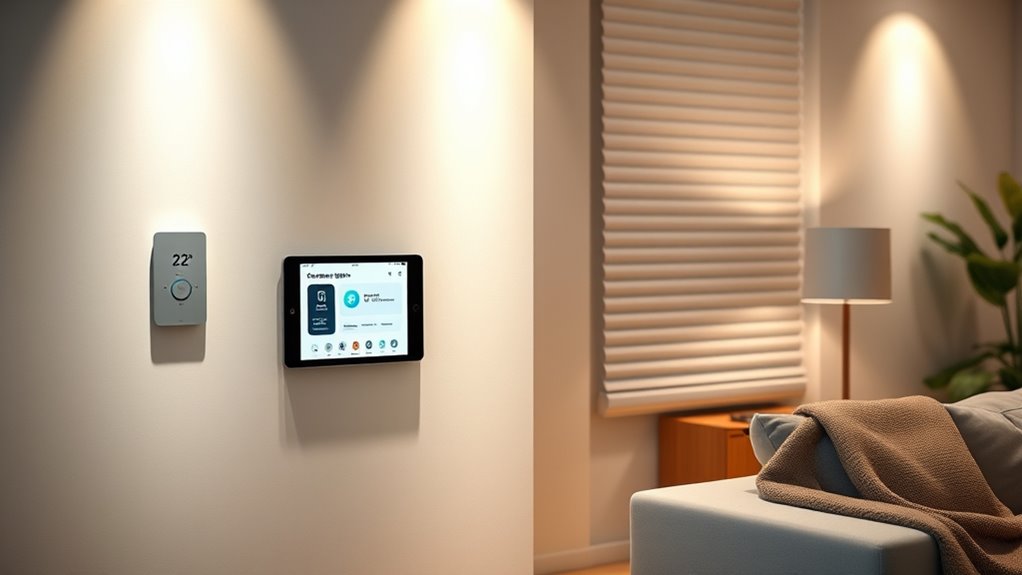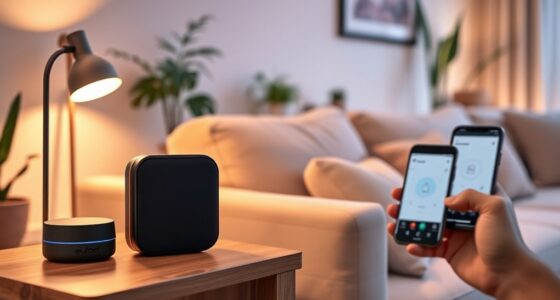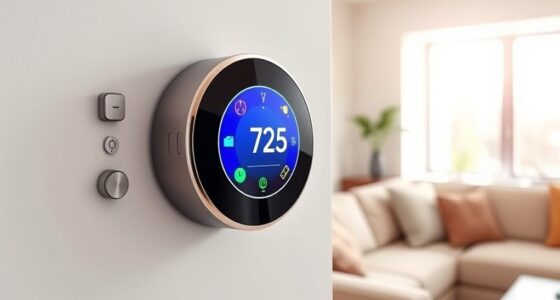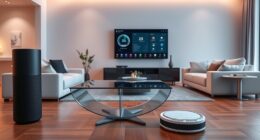To simplify your daily life, set up routines that automate lighting, thermostats, and security systems. You can program lights to turn on at cozy levels when you arrive home, schedule your thermostat for ideal comfort, and lock doors automatically when you leave. Using motion sensors and voice commands, you’ll enhance security and conserve energy effortlessly. Explore more smart routines to make your home truly responsive and tailored to your lifestyle.
Key Takeaways
- Automate lighting, blinds, and temperature adjustments to create a comfortable environment tailored to daily routines.
- Schedule smart devices to turn off when rooms are vacant, enhancing energy efficiency.
- Set routines to lock doors and activate security cameras before leaving home or at night.
- Create morning and evening routines that include gentle lighting, music, and climate control for added convenience.
- Integrate entertainment systems with security and lighting for seamless, immersive home experiences.

Smart home automation can transform the way you live by making everyday tasks more convenient and efficient. With the right routines, you can save energy, boost security, and create a more comfortable living environment. Imagine walking into your home and having everything adjust automatically — the lights turn on at a cozy level, the thermostat sets to the perfect temperature, and your security system arms itself seamlessly. These small but impactful changes can considerably improve your daily life.
One of the most practical ways to utilize automation is through energy efficiency. You can set your smart lights to turn off automatically when you leave a room, reducing unnecessary power consumption. Smart thermostats are especially useful—they learn your schedule and preferences, adjusting the temperature to save energy when you’re away or asleep. You might also program your blinds or curtains to open in the morning and close at night, optimizing natural light during the day and maintaining privacy at night. These routines not only cut down on your utility bills but also contribute to a greener footprint. Plus, the convenience of controlling everything from an app or voice command means you don’t have to remember to flip switches or adjust thermostats manually.
Security enhancements are another essential aspect of smart home automation. You can set up routines that automatically lock doors and activate security cameras when you leave home, giving you peace of mind even when you’re miles away. Smart locks are easy to program, allowing you to grant temporary access to guests or service providers without handing over physical keys. Motion sensors can trigger alerts or turn on exterior lights if unexpected movement is detected, deterring potential intruders. Integrating your security system with your smart doorbell or surveillance cameras provides real-time updates and recordings you can review at your convenience. These features help protect your home proactively, making your living space safer without constant manual effort. Additionally, understanding the importance of home theatre projectors can elevate your entertainment experience at home.
Combining energy efficiency and security enhancements through automation doesn’t mean sacrificing comfort. You can create routines that prepare your home for different times of the day — waking up to gentle lighting, a warm shower, and your favorite music, all set automatically. When you’re heading out, your routine can turn off unnecessary devices, lock doors, and activate security measures, saving energy and ensuring safety. Returning home, your smart system can greet you by adjusting the lighting and temperature to your preferences. These smart routines make your home more responsive, saving you time and effort while increasing safety and efficiency. With a few simple setups, you’ll find that automation enhances your lifestyle in ways you never expected.
Frequently Asked Questions
How Secure Are Smart Home Automation Systems From Hacking?
Smart home automation systems can be vulnerable to hacking, but strong cybersecurity measures substantially reduce risks. You should regularly update firmware, use strong, unique passwords, and enable two-factor authentication. Be aware of privacy concerns, like data breaches or unauthorized access to your devices. By taking these precautions, you help protect your smart home from threats, ensuring your connected devices stay secure and your personal information remains private.
Can I Integrate Multiple Brands of Smart Devices Easily?
You can absolutely integrate multiple brands of smart devices easily. While some worry about device compatibility, most modern systems support brand integration through hubs or compatible apps. Using platforms like Alexa, Google Assistant, or Apple HomeKit, you can connect different brands seamlessly. This flexibility allows you to personalize your smart home setup without worrying about compatibility issues, giving you the convenience of a cohesive, multi-brand smart home experience.
What Is the Average Cost to Set up a Smart Home System?
The average cost to set up a smart home system varies based on your device choices and installation costs. You can expect device pricing to range from $50 for basic smart bulbs to several hundred dollars for more advanced equipment like security cameras or smart thermostats. Installation costs may add to this, especially if you hire professionals. Overall, plan for a total setup cost of a few hundred to a few thousand dollars, depending on your needs.
How Energy-Efficient Are Smart Home Routines Over Traditional Methods?
Smart home routines substantially boost energy savings compared to traditional methods. You’ll notice reduced utility bills as automation optimizes usage, like adjusting thermostats or turning off unused devices. These routines also lower your environmental impact by reducing unnecessary energy consumption. By integrating smart systems, you actively contribute to a greener lifestyle while enjoying the convenience of efficient, automated control over your home’s energy use.
Are Smart Home Devices Suitable for Elderly or Disabled Users?
Smart home devices can be suitable for elderly or disabled users if they address accessibility challenges. Look for devices with user-friendly interfaces, large buttons, voice control, and simple setup. These features help make technology easier to operate, enhancing independence and safety. By choosing accessible, intuitive smart home solutions, you can guarantee everyone benefits from automation without frustration or difficulty.
Conclusion
So, while your smart home handles everything from lights to locks, you might finally have time to master that hobby or simply enjoy a nap. Ironically, all these routines are designed to free up your day—yet here you are, still tweaking settings and dreaming of the perfect automation. But hey, at least you can rest easy knowing your home’s smarter than ever, even if it’s just so you don’t have to do the small stuff anymore.
Alfons is the visionary leader and driving force behind Voyager Info’s success. As the Editor in Chief, he brings a wealth of experience and an unwavering passion for travel to the helm of our cruise-centric platform.
With a lifelong fascination for exploring new horizons, Alfons discovered his love for the ocean and cruising at a young age. From sailing across pristine Caribbean waters to embarking on daring expeditions to far-flung destinations, he has amassed a treasure trove of first-hand experiences in the world of cruising.










